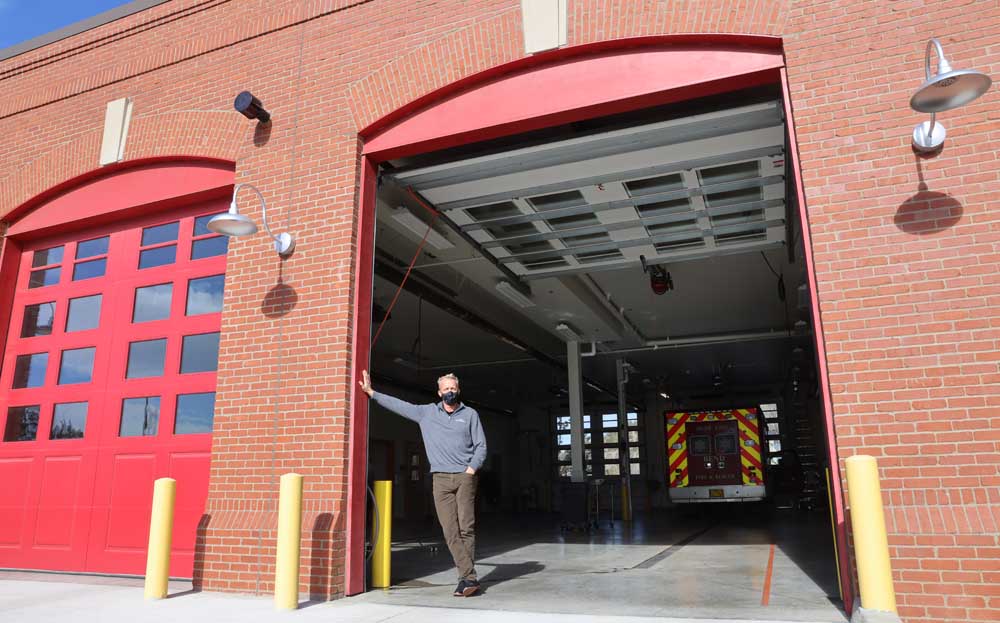Staffing fire engine at Pilot Butte might take raising tax levy
Published 5:00 am Thursday, October 28, 2021

- Bend Fire & Rescue Chief Todd Riley at the Pilot Butte substation.
Smack in the middle of Bend is a 10,000-square-foot fire station, complete with spacious kitchen, workout and day rooms, sleeping quarters and even a nickname for the red brick building at the base of Pilot Butte: “The Rock at Midtown.” The architects that designed the two-story, $3.9 million station called it “a state of the art facility.”
What Fire Station 6 doesn’t have, at the moment, is firefighters.
Nearly two years old, Bend Fire & Rescue’s Pilot Butte substation houses only two ambulances, but was designed to also accommodate an engine and the nine firefighters required to staff one.
“It still kinda smells new,” Bend Fire Chief Todd Riley said on a walkthrough of the half-empty apparatus bay Wednesday.
Officials cut the ribbon on the substation, a replica of Bend’s original downtown brick firehouse, in January 2020.
Bend Fire operates in partnership with the Bend Rural Fire Protection District No. 2. Funding for the substation was provided by the rural district, and the land was provided, at no cost, by the city. But at the time the project came online, Bend Fire could not afford to equip and staff an engine full-time.
To get some use out of the station, the agency moved two EMS units there, along with a battalion chief and a Quick Response Vehicle — a Ford Explorer driven by a paramedic who offers patient assessment for lower-tiered emergencies.
Around 80% of 911 calls in Deschutes County are medical calls requiring only an ambulance. But engines “do it all,” Riley said, responding to vehicle crashes, rescues and structure and wildland fires, in addition to medical calls.
Pilot Butte is the department’s sixth fire station. Four others form a ring around the city, with a fifth located in Tumalo. The Pilot Butte station is located in the center of the ring. The plan, if the Pilot Butte station gets an engine, is for that engine to supplement the other substations.
Funding nine new firefighter-paramedic positions would add another $1.3 million to the agency’s approximately $32 million annual budget.
Riley learned this month the agency’s recent application for a federal Staffing for Adequate Emergency Response grant that would have funded nine firefighters had failed. In response, he and City Manager Eric King resumed talking about how and when to float another tax levy to Bend voters.
In 2014, Bend Fire first went out for a local option levy, which passed. The tax allowed the department to roll out its two-tiered emergency response system and add staff around town.
Now, the agency’s budget is again maxed out, and Riley said the only way for the city to get more firefighters in the Pilot Butte substation is by passing a tax levy at a higher rate.
Riley anticipates the city would contract with a polling company to help figure what rate the community is willing to support. Then a ballot question could be put to voters as early as November 2022. Even it were to pass, the revenue would not become available for two years, meaning the earliest a fire engine could get to the Pilot Butte substation is likely 2024.
For now, the west wing of the substation is rented out as classroom space by the Bend Police Department, whose station nearby is also said to be crowded. Riley said he will pursue a federal grant next year but he acknowledges many fire agencies could use funding for adequate staffing, given that job requirements are becoming more exclusive in emergency services.
June, July and August were the three busiest months in emergency service in the city’s history.
Bend Fire currently touts an average emergency response time of around 6 minutes. With an engine at Pilot Butte, that number could conceivably drop even lower, Riley said.
But without expanding the budget, the number could creep up to level that doesn’t meet city goals, Riley said.
“More people are moving to Bend. More people are visiting Bend. Bend is becoming more and more dense,” Riley said. “We don’t see call volume going down.”
Editor’s note: This article has been corrected. The original version misstated the annual fire department budget, and the cost of adding nine firefighters, due to incorrect information provided to The Bulletin.
The Bulletin regrets the errors.








